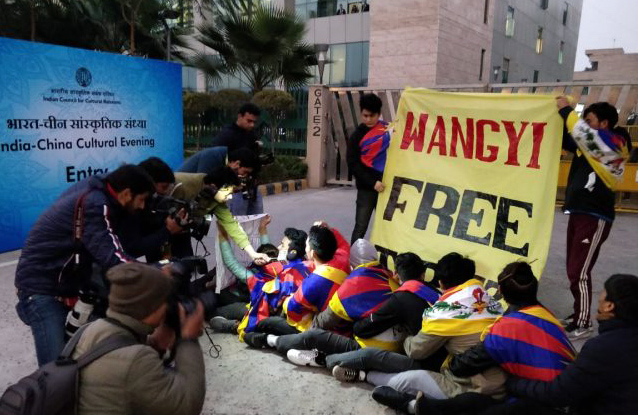
(TibetanReview.net, Dec23, 2018) – Police in India’s capital New Delhi took way 12 Tibetans as they staged a protest against China’s State Councilor and Foreign Minister Wang Yi on Dec 21. The incident took place just 15 minutes before Wang arrived at the Pravasi Bharatiya Kendra (overseas Indian affairs centre of the External Affairs Ministry) to jointly inaugurate with his Indian counterpart Ms Sushma Swaraj a high-level India-China High-Level Mechanism on Cultural and People-to-People Exchanges.
The Tibetans shouted slogans demanding Freedom for Tibet. The venue is located in the diplomatic enclave of Chanakypuri.
The protest was led by a group called Students for a Free Tibet which calls for Tibet’s independence from Chinese occupation rule.
Also, minutes before Wang’s arrival, Tibetan activists put up a massive banner on the flyover outside Terminal 3 of Indira Gandhi International Airport, asking China to vacate Tibet, reported the ANI news agency Dec 21.
The report cited a statement from India’s Ministry of External Affairs as saying the newly constituted India-China High-Level Mechanism on Cultural and People-to-People Exchanges was established pursuant to the decision taken by Prime Minister Narendra Modi and President Xi Jinping of China, during their informal summit in Wuhan in April this year.
The report quoted Swaraj as saying, “I’m satisfied with the quality of discussion today. Ten priorities we discussed include enhancing cooperation in films, education, tourism, art, yoga, media, culture, sports, academics and youth exchanges.”
She has added, “today’s meeting was unique and very different as it was based on only two subjects, including cultural relations between India and China, and people-to-people relation between both the Asian countries.”
China’s official Xinhua news agency Dec 21 cited China and India as saying that establishing the high-level people to people exchanges mechanism was an important measure to develop the all-round bilateral relations between the two countries.
It also cited Wang as saying the exchange mechanism will help in consolidating the public opinion foundation for the development of bilateral ties, promoting the healthy development of bilateral ties, pushing forward the peaceful coexistence among different civilizations and jointly maintaining the world peace and stability,
Wang is on a four-day trip to India.
* * *
On the same day, China was reported to have dismissed as untrue a US media report that alleged that it had hatched a secret plan to build fighter jets and other military hardware in Pakistan as part of the $60 billion China-Pakistan Economic Corridor (CPEC) project which is opposed by India.
The CPEC, which connects Gwadar Port in Balochistan with Chinese-ruled East Turkestan (Xinjiang), is a flagship project of Chinese President Xi Jinping’s ambitious Belt and Road Initiative (BRI). The Islamabad-datelined report in the New York Times said Pakistani Air Force and Chinese officials were putting the final touches to the secret proposal.
The report said, “Chinese officials have repeatedly said the Belt and Road is purely an economic project with peaceful intent. But with its plan for Pakistan, China is for the first time explicitly tying a Belt and Road proposal to its military ambitions – and confirming the concerns of a host of nations who suspect the infrastructure initiative is really about helping China project armed might.”





